Remembering Harry
The death of Harry (H.R.F.) Keating occurred as the April edition of this column was at the printers, but was ably covered in the ‘Blog’ section and elsewhere and I was honoured to be given several chances to express my memories of someone who could genuinely be called a guru of crime fiction. Many were touched by Harry’s passing, showing that he was held in high and truly international regard.
Retired Swedish editor (and crime and thriller expert) Iwan Morelius, now living in Spain, who first met Harry in 1973, sent me this picture of Harry at a crime symposium at the Sorbonne in Paris in 1999.
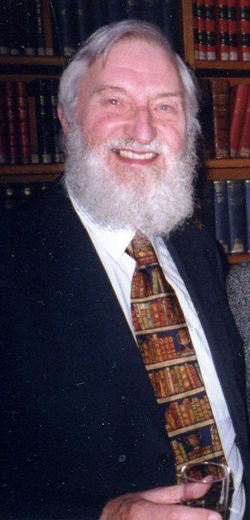 Then Jeff Kingston Pierce, the editor of the influential American Rap Sheet blog, asked me to recommend to him (as a reader) my favourite Keating novels. I gladly listed my favourite Inspector Ghote books and several non-Ghote crime novels as well as Harry’s non-fiction on the art of crime writing. Almost as an afterthought, I mentioned to Jeff that Harry had once told me that the über-critic Julian Symons (to whom Harry introduced me when I was a fledgling reviewer) had always maintained that his non-crime novel from 1978, A Long Walk to Wimbledon, was his “best book”.
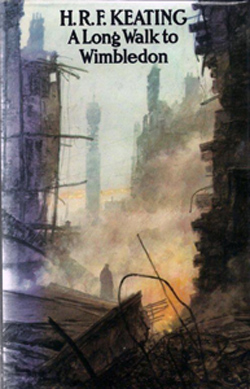
Even as I mentioned this, I had to admit that I had not read it but immediately decided to track down a copy. It is indeed a very good novel, set in dystopian near future when society has imploded and London is in ruins, both physically and morally. A mild-mannered hero has to get from Highgate to Wimbledon to see his estranged wife and he has to walk across a landscape which makes the wartime Blitz damage look like cosmetic improvements. The characters he meets on his way – some dangerous, some crazy – are fascinating, in particular an Indian (surprise, surprise!) academic Dr Satpathi who under the new feral regimes springing up among the rubble faces persecution for being a “tropical”.
It is a remarkable feat of imaginative writing, all the more impressive for its downbeat and un-sensational approach to the urban apocalypse which has simply crept up and destroyed London a in frighteningly ordinary way – no alien invasions, no bubonic plague, no zombies.
I am really glad I found a copy so quickly, for at Harry’s funeral on April 15th, in her tribute, Baroness (P.D.) James urged the assembled mourners not only to appreciate Harry’s contribution to detective fiction, but also to remember his non-crime novels and in particular cited A Long Walk to Wimbledon, which she said showed a “breathtaking imagination”.
The attendance at Harry’s funeral showed the respect he was held in, with representatives of the Society of Authors, the Crime Writers Association, the Dorothy L. Sayers Society and the Detection Club, including: Margaret Yorke, Simon Brett, Donald Rumbelow, Andrew Taylor and Michael Hartland.
If anyone wants to belatedly discover Harry Keating’s most famous creation Inspector Ghote – the Maigret of Mumbai – then this is a good time as Penguin Modern Classics have just republished four of his most famous cases in a very attractive new livery and with an Introduction by Alexander McCall Smith.
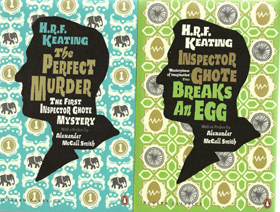

Giving Reviewers a Bad Name
I was, quite frankly, shocked that the once-great newspaper the Daily Telegraph saw fit to devote half a page of its precious newsprint to trashing the thrillers of South African writer Wilbur Smith; and indeed Wilbur Smith himself. But then I suppose times have changed as for many years I had assumed that 78-year-old millionaires with colonial pasts and wives almost forty years their junior, formed part of the paper’s core readership.
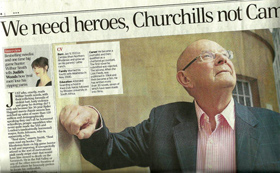
The feature, written to mark the publication of his latest novel from Macmillan, Those In Peril, begins ominously with: “Just who, exactly, reads Wilbur Smith novels, with their rollicking formula of violent lust, lusty violence and gung-ho derring-do? I only ask because this 30-year Ryder Haggard-meets-Razzle oeuvre has notched up sales of more than 120 million and demographically speaking they can’t all be hormonal schoolboys, priapic squaddies who never quite made the SAS and London’s (undoubtedly hormonal) mayor, Boris Johnson, who is, apparently, a fan.”
Now the thing that shocked me first of all was that the Telegraph has clearly dispensed with all its sub-editors, otherwise someone with a grasp of basic arithmetic would surely have noticed that a writer first published in 1964 has had more than a ‘30-year’ career. More importantly, they would probably have ensured that Sir Henry Rider Haggard’s name was spelled correctly.
It is clear from the off that the writer of this feature does not like Wilbur Smith, nor his books and can hardly contain her desire to ask his ‘gorgeous’ fourth wife (39 years younger than him in case you’d forgotten); “What exactly first attracted you to millionaire Wilbur Smith?” And just to make sure we get the point, journalist Judith Woods adds: “The photographs of them cuddling up together make slightly uncomfortable viewing, as he looks like her elderly father....”
Journalist Judith Woods recently penned features on The Royal Wedding Bouquet and A Royal Home Awaits its Renaissance and according to the site www.journalisted.com writes mostly about London (though has written about “Boden” quite a lot, whatever that is) and at least twice in this article name-checks Boris Johnson.
Wilbur Smith the man comes in for some sly stick not only for his marriage, the implication that he is “unencumbered by” and on occasion “downright uncharitable” to his children and grandchildren, an apparent obsession with the taxman, his homes in Britain, Malta, Cape Town and Switzerland and, curiously, for wearing a “metrosexual pink candy striped shirt”. I say curious, because this looks to me exactly like the gentleman’s shirts so often advertised (at very reasonable prices) in the pages of the Daily Telegraph.
As to Wilbur Smith the writer and his new book, Judith Woods pulls as few punches as the old Batman TV series: “Writing bloodthirsty, mucky books isn’t something I’d like any son of mine to aspire to” (Biff!), “...the most awful book I have ever read” (Whap!) “By page 17 I was wincing at the rather one-sided sex” (Thud!) “By page 30 I had thrown it down in revulsion...” (Zap!) “It certainly makes a change from sensitive Nick Hornby bloke lit” (Kerpow!).
I am reminded of my mother’s dictum that if you can’t say anything nice about someone, just say nothing at all; a philosophy she stuck to rigidly except when it came to Adolf Hitler and the films of Jerry Lewis (without Dean Martin).
Now I cannot comment on Those in Peril as I was not sent a copy to review but I must admit that I was mightily impressed when I read Smith’s first African adventure When The Lion Feeds at the tender (‘hormonal’?) age of 13, though as I recall there were far more sexually explicit thrillers around then if all one was after was teenage titillation. I must also admit that the last one I read was over 35 years ago, which perhaps says something, though I am not sure quite what.
However, I am concerned that the Telegraph should devote a whole half-page to such a dissection of an author (rather than his books) when the same newspaper allows its distinguished crime and thriller reviewers only a few meagre column inches to recommend, usually with excellent judgement, books to readers.
I am grateful to the feature-writer, though, for reminding me to check whether my subscription to Razzle magazine needs renewing.....
Diamond Anniversary
Although my much-loved Penguin green-back edition is only 57 years old, it is actually 60 years this year since Josephine Tey’s The Daughter of Time was first published.
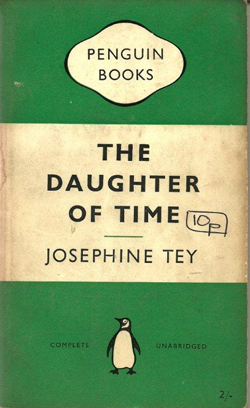
Probably the best known work of Elizabeth MacKintosh, who wrote novels as ‘Josephine Tey’ and plays as ‘Gordon Daviot’, (although The Franchise Affair comes close), Daughter of Time is the ultimate ‘cold case’ crime novel in which Tey’s bed-ridden police detective, Alan Grant, investigates the 15th-century “Princes in the Tower” murder, previously pinned (by Shakespeare among others) on that great English king Richard III.
It is regularly voted into the top ten whenever anyone takes a poll of favourite detective stories and I am delighted to say that it seems to be still in print. If the name Josephine Tey means nothing to you (and you are duly shamed into admitting that), there is an excellent article by Catherine Hunt on her as a ‘Past Master’ of the genre posted in the Features section of this very website.
Reviewing The Late Review
It was some years ago now that it became law that there had to be a Scottish person on every edition of BBC 2’s Late Review, a usually very serious discussion programme covering all things cultural and artistic which of course means very little crime fiction, unless it is of Scandinavian origin.
I am unsure how much longer either of these policies will continue following the guest appearance of the awesomely talented (and in private, very funny), award-winning Scottish crime writer Denise Mina who, coincidentally, has a new novel out this month, The End of the Wasp Season, from publishers Orion.
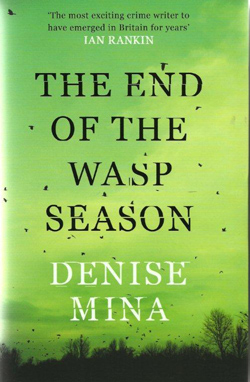
Among topics discussed in the March show was the new (and last?) Wallander novel by Henning Mankell. An icy, positively Nordic, chill descended on the studio where Denise, quietly but firmly, declared that she was “really surprised at how badly it was written”.
Mediterranean Mayhem
The British have always had a ‘thing’ for fictional murder and mayhem set in Mediterranean climes. Perhaps it stemmed from a jealousy of the warm climate, relaxed licensing laws, good food and cheap booze, but whatever the underlying reasons, we Brits have shown a deep fondness for the murderous investigations conducted by the likes of Michael Dibdin’s Zen, Andrea Camilleri’s Inspector Montalbano, Robert Wilson’s Javier Falcon, Magdalene Nabb’s Marshal Guarnaccia and even Donna Leon’s Guido Brunetti.
But one fictional detective pre-dates all these beloved characters: Mallorcan policeman Inspector Alvarez, who first appeared in print in 1974 and whose 35th case, Murder Majorcan Style, is now published by Severn House.
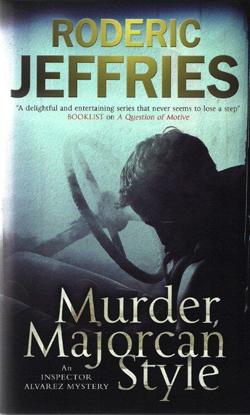
Apart from being a prolific author the creator of Alvarez, Roderic Jeffries, who lives on Majorca, has another claim to fame – at least in my eyes – as I believe he is the only crime-writer still writing who had the first of his 130-odd books published before I was born.
|
Great Set Up
Those perky publishers at Penguin recently sent me their ‘biggest action-thriller debut for a decade’, The Set Up by Felix Riley.
I was immediately attracted to this book as the premise of the plot appears to be the cold-blooded murder of four influential bankers in the first chapter. Surely, a novel with such a sympathetic plot hook couldn’t be all bad.
Sadly, I never found out as the first chapter was as far as I got. I fear the staccato prose style and profusion of references to characters either by the initials of their job titles (though I thought someone being a COO was rather cute) got the better of my creaking, alcohol-ravaged brain. I was also brought up short by the description of the murder weapon as ‘an automatic revolver’ something I had never come across before.
I will have to contact one of my many readers who live in heavily-armed gated communities in Montana and ask them exactly what ‘an automatic revolver’ is.
Court in Session
Goldsboro Books, now London’s leading mystery bookshop, is throwing open its doors on 21st June for an open evening entitled Crime in the Court after its address in the exclusive Cecil Court in the heart of London’s West End. (See http://www.crimeinthecourt.com/)
A whole galaxy of crime-writing stars are expected to rub shoulders with fans and, most importantly, paying customers and I am tempted to buy a £5 ticket under a false name and infiltrate the evening if only for the pleasure of rubbing shoulders with that uber-curmudgeon, John Lawton. Rarely seen outside his Berchtesgarten-style Derbyshire retreat these days, I know John will be looking forward to acting as “meeter and greeter” for the evening and going out of his way to answer all the questions fans may have, however trivial and personal.
Crime in the Court is a new event on the crime fiction social calendar and for the benefit of civilians, I provide this useful (and possibly accurate) list of dates which should be entered into diaries if they are not already there.
19-22 May: CRIMEFEST in Bristol (with special guest Deon Meyer)
21 June: CRIME IN THE COURT at Goldsboro Books in London
19 July: BODIES IN THE BOOKSHOP at Heffer’s in Cambridge
21-24 July: HARROGATE FESTIVAL OF CRIME WRITING (starring Lee Child)
19-21 August: ST HILDA’S CRIME CONVENTION, St Hilda’s College, Oxford
10-13 November: READING FESTIVAL OF CRIME WRITING (with Minette Walters)
Whether I manage to attend any of these events depends on the usual legal reasons (‘exclusion order’ is such an ugly expression) and my rate of recovery from the sumptuous summer parties celebrating the 25th birthdays of both Headline and Serpent’s Tail, to which I am greatly looking forward.
Caught in Court
I have to admit to having already sampled the hospitality of Goldsboro Books in Cecil Court at a launch party for Imogen Roberston’s most excellent 18th-century mystery set in the Lake District, Island of Bones.
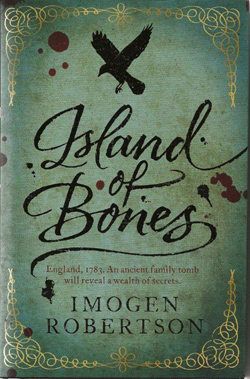
It was a pleasure to meet David Headley, the mastermind behind what is becoming known as the party venue for crime and thriller publishing...

...and to be able to catch up on the latest gossip (and indeed start one or two rumours) with young Jake Kerridge of the Daily Telegraph and the distinguished crime-writing duo that is ‘Nicci French’ (Nicci Gerard and husband Sean French).
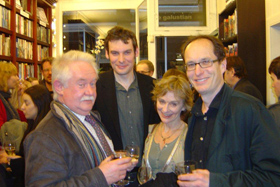
As the event was hosted by the publisher of Island of Bones, Headline – a responsible as well as generous publisher – and took place in an establishment absolutely stuffed to the eaves with rare, signed first editions of classic thrillers, I found myself shadowed at all times by members of Headline’s crack security squad.
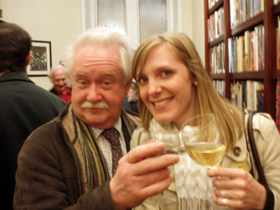
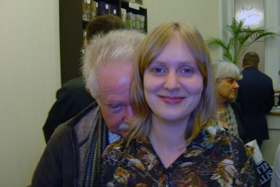
Quite why I attracted such close attention by the dedicated team from Headline I am not sure; but I am not complaining.
So Many Books, So Little Time
It was with only mild regret that I gave my invitation to last month’s Royal Wedding to my factotum Waldo (who got, I am told, a good price on something called “e-Bay”) but the postman delivered so many exciting books in the week before Easter that I decided I simply had not the time for all that dressing up in uniforms and being polite. In any case, reading during a service in the Abbey is frowned upon for some reason and on more than one occasion I have been ejected for chuckling out loud at a bon mot in a picaresque Michael Innes.
But the box of new titles I received are certainly worth some quality reading time. In particular, I am looking forward to the second Icelandic thriller in the series ‘Fire and Ice’, 66° North by Michael Ridpath, who long ago, and wisely, abandoned his day job as a bond trader in the City to become a successful author.
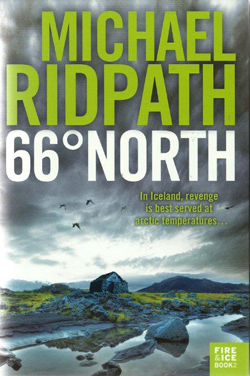
I really enjoyed the first in the series (also from Corvus), the Lord of the Rings inspired Where the Shadows Lie and admired Mr Ridpath for his willingness to take the crime-writing fight to the Nordic invader. In fact you might say that, using the word in its original sense, Michael Ridpath was going a-viking in the land of the Norsemen.
For a regular refresher course in 19th-century Russian history and literature, I always turn to the investigations of magistrate Porfiry Petrovich as described by R.N. Morris, currently in The Cleansing Flame from those fabulous Faber people.
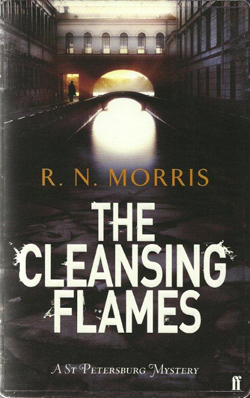
I am sure my readers do not need telling that the character of Porfiry Petrovich first appeared in Dostoevsky’s novel Crime and Punishment and Roger Morris has cheekily and quite brilliantly appropriated him for further investigations, the latest set in St Petersburg in 1872, with revolution, arson and of course murder in the air.
Staggeringly, it is almost five years since British thriller writer Nick Stone burst on the scene and I have been looking forward for some time to his third Max Mingus novel, Voodoo Eyes which arrives this month from his new publisher Sphere.
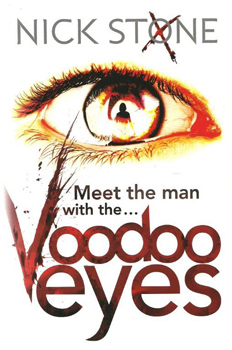
With their Miami-Haitian-Cuban settings and an awesomely scary villain in the shape of Solomon Boukman – who some describe as Baron Samedi’s vicar on Earth – no one, but no one, is writing thrillers quite like Nick Stone.
And I am delighted to have – finally – a UK edition of South African Roger Smith’s first thriller, Mixed Blood, in my hot little hands, thanks to Serpent’s Tail.
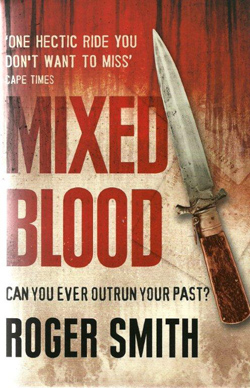
Mixed Blood was a bestseller in America and numerous European countries when first published in 2009 and it was his second novel, Wake Up Dead, which was published first in the UK. I thought that book, brutal and believably streetwise as it was, quite superb and was anxious to read Roger’s first before his third (Dust Devils) appears later this summer.
With books like these coming out, who has time for wedding cake and toasting bridesmaids?
Going Foreign
The imported flavour of the month seems to be Danish, not only with the television series The Killing which certainly got the chattering classes squirming on their futons and spilling their Chilean Chardonnay, but with the publication this month of the much-heralded novel Mercy from Penguin.
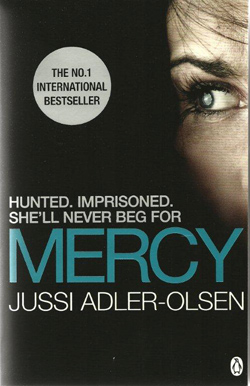
The first in the bestselling ‘Department Q’ series (Dept. Q being a home for ‘hopeless’ cases which can’t or won’t be dealt with by Copenhagen’s finest) by Jussi Adler-Olsen, who is actually in England this month and will be interviewed by none other than the multilingual Professor Barry Forshaw.
In fact, Professor Barry has a ‘double-header’ of Nordic writers to quiz for not only is Jussi Adler-Olsen getting the Forshaw grilling, but so too is a relatively unknown (here) debut crime novelist from northern climes: Sissel-Jo Gazan. Privately, Barry confided that although he knew Jussi Adler-Olsen from a previous meeting, he was slightly worried about recognising Sissel-Jo. To prevent embarrassing mix ups, I provide photographs of both and am sure there will be no confusion on the day.

Jussi

Sissel-Jo
For legal reasons I am unlikely to attend the event nor tell you anything about Ms Gazan’s forthcoming book, but I am hoping to catch up at one of the events on Professor Forshaw’s nationwide tour promoting Scandinavian crime fiction, which has covered sell-out venues from Scarborough (where they have long memories when it comes to Vikings) to the Danish Embassy in London, to the University of Hertfordshire. For his unstinting efforts, a Nobel Prize – or perhaps a chair in Old Norse at the University of Hertfordshire – surely cannot be long in coming.
I have to admit that the present addiction here at Ripster Hall is of a French persuasion now that I have discovered that there are more than two BBC television channels.
|
Currently showing on BBC4 is the excellent ensemble policier series Spiral and for those without a decent education the BBC provides subtitles (which do not quite accurately reflect the swearing, but it’s close). In France, of course, the series is known as Engrenages which is, admittedly, tricky to translate and remain dramatic as it means ‘gears’ (or, I suppose, cogs on a spiral driveshaft) and is a star vehicle for the delicious Caroline Proust as top cop Laure Berthaud.
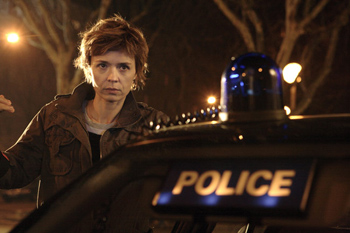
For my money, though, the series should be applauded for the complex character of the investigative Judge Roban played by Philippe Duclos, for it is so refreshing to see such a dashing young actor given such a dashingly youthful role.

The Dowager Lady Ripster tells me that I have made a mistake and that the really dashing youthful hero is the rather serious young man who plays the disillusioned lawyer, but I shall stick to my guns. I know I am getting older when the judges start looking younger....
Not French at All
I must immediately make a point of clarification.
The new novel Spiral from Headline has nothing to do with the French television series. In fact it is written by American Paul McEuen and involves a diabolical kamikaze plot left unfinished at the end of World War II, biological warfare which could exterminate the human race (or at least Americans) and spider-like ‘nanobots’ in high security facilities.
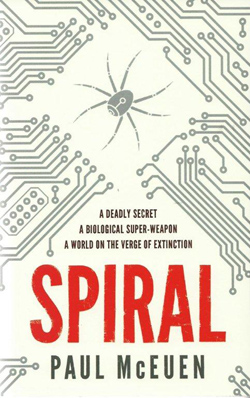
It is a fast-moving apocalyptic thriller which requires a huge suspension of disbelief as both the main hero and baddy are in their mid-80’s (though I’m all for youthful protagonists in thrillers). Whilst many publishers have been desperately (really desperately) trying to find ‘the next Dan Brown’ it seems that Headline have been on the look-out for the next Michael Crichton; and they may just have found him.
Ten Little.....
I hear that there is some concern among collectors of fine hardbacks (yes, they still exist – hardbacks I mean) about the availability of one particular Agatha Christie title in the superb series from HarperCollins of facsimile editions, mostly from the legendary Collins Crime Club.
These are (so I am told) wonderfully produced editions in their original livery, which have been appearing over the past two years, but collectors of complete sets (I believe they are known as ‘completists’) are anxiously awaiting news on whether one of Dame Agatha’s most famous (and in my opinion, best) crime novels will be re-issued in the series.
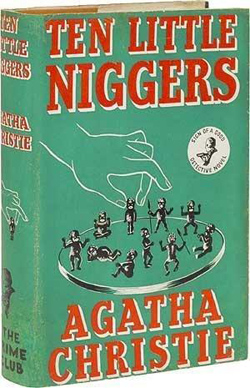
I refer of course to her 1939 tour-de-force Ten Little Niggers, a title which may well be regarded as far too insensitive for these politically correct times. The book has famously been re-named as And Then There Were None and the equally insensitive Ten Little Indians but was again available as a mass market paperback as Ten Little Niggers in the 1970s and 1980s.
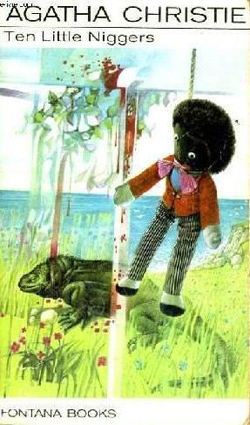
I do hope there will be a facsimile edition of Ten Little Niggers, for any Christie collection would be bereft without it. I, and many others, regard it as a true classic of 20th century crime fiction and it is my favourite Christie as on first reading I was (and still am) totally gobsmacked by the sheer hutzpah of the audacious plotting and the skill with which the Great Dame pulled it off.
Sticking (tenuously) to a Christie theme, I have to congratulate Agatha’s great-grandson James Pritchard on his latest venture, Langtail Press.
In a previous life at publisher’s Collins, James Pritchard had the unenviable task of trying to sell some of my early ‘Angel’ novels. I am delighted to say he survived that harrowing experience and has branched out as a publisher in his own right with Langtail (www.langtailpress.com) which specialises in print-on-demand of out-of-print but not forgotten books, mostly in the crime genre.
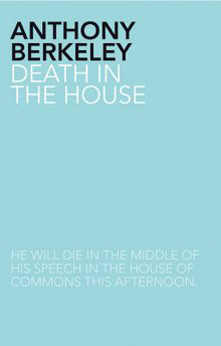
I was personally delighted to see that Langtail are holding a torch for that outstanding ‘Golden Age’ crime writer (and one of my predecessors as crime critic on the Daily Telegraph), Anthony Berkeley, and especially for re-issuing Death in the House from 1939, which was, until now, one of the few Berkeleys I had not read.
Other goodies from Langtail (and more are promised) include titles from Elizabeth Ferrars, Ellery Queen, Freeman Wills Croft, P.M. Hubbard, that sadly forgotten, double winner of Gold Daggers Joan Fleming (1908-1980) and the disgracefully overlooked (not even getting a mention in a recent genre “encyclopedia”) Gavin Black (1913-1998) who wrote some pretty top notch thrillers, most notably with Far Eastern settings.
And since....
And since I have digressed on to the subjects of classic crime reissues, top notch thrillers and print-on-demand editions, I really must mention the latest title from Ostara Publishing’s Cambridge Crime imprint, T.H. White’s 1932 novel (described as “a giant among crime stories” by the Irish Times) Darkness At Pemberley.
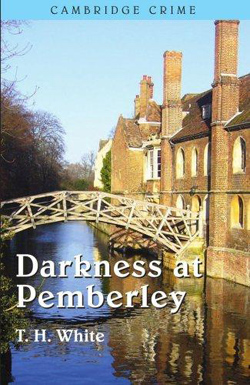
Terence Hanbury White (1906-1964) wrote poetry and books on hunting and sport as well as detective novels but is probably best known for his retelling of the Arthurian legend in the quartet The Once and Future King, which included the famous The Sword in the Stone (later to become a cringe-worthy Disney animated film) and the less well-known The Candle in the Wind which had nothing at all to do with Sir Elton John.
The latest top notch thrillers to be republished by Ostara’s Top Notch Thrillers imprint (see what I did there?) are books starring two iconic heroes from the 1960s.
The Eliminator, written by the prolific author Christopher Nicole under the pen name Andrew York, introduced the character Jonas Wilde, the taciturn professional assassin used by a shady sub-division of British Intelligence.
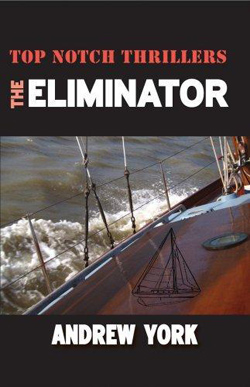
For the background to how The Eliminator became a TNT reissue and the web of coincidences involved in the process, I recommend the feature posted on the official Ostara website at http://www.ostarapublishing.co.uk/article-93.html.
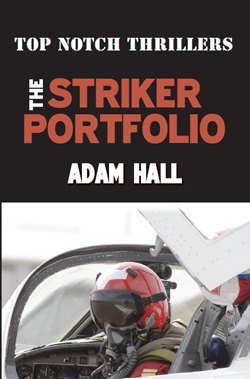
The super tough, tightly-wrapped special agent ‘Quiller’ should need no introduction to any student of spy thrillers from the second half of the 20th century. His third outing, first published in 1969, was The Striker Portfolio by Adam Hall, the pen-name of novelist Elleston Trevor and sees Quiller operating (alone as usual) in Cold War West Germany where British-designed NATO jet fighters are falling out of the sky in a series of unexplained fatal ‘accidents’.
In its day, The Striker Portfolio would have been highly topical, with the on-going debates about the cancellation of the highly advanced British TSR-2 strike aircraft and it also contains one of the best and most detailed car chases in spy fiction, which takes place between a Mercedes 300 and the revolutionary NSU RO-80, which should impress all fans of that excellent programme Top Gear.
The TNT edition comes with a previously unpublished Afterword (“Life Like Quiller Part II”) by Jean-Pierre Trevor, the son of Elleston Trevor, an illustrated version of which can be seen at http://www.ostarapublishing.co.uk/article-92.html.
An Angel at Your Side
Following my revelation that an ancient ‘Angel’ book had been found on an archaeological site in Central America, I hear of a similarly amazing find in Italy at Piana San Martino.
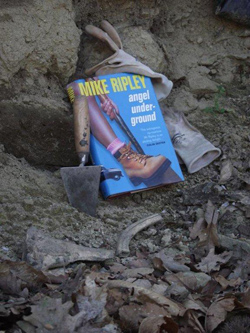
As the news comes courtesy of Verbena (Ben) Pastor, who is both a distinguished archaeologist and a distinguished crime-writer, it must be true.

Keen-eyed readers, however, do not have to be archaeologists in order to spot the new edition of Angel City which is published almost any day now by Telos Publishing.
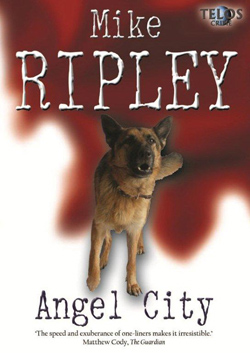
Toodles!
The Ripster
|